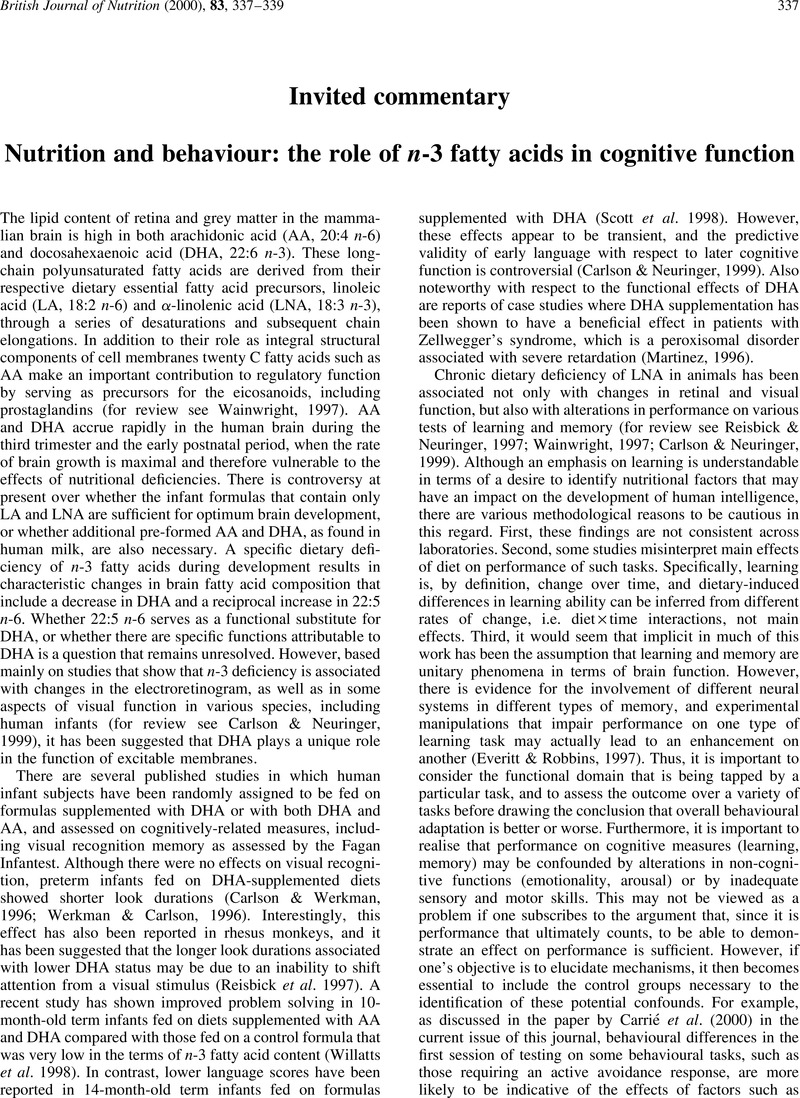No CrossRef data available.
Article contents
Nutrition and behaviour: the role of n-3 fatty acids in cognitive function
Published online by Cambridge University Press: 09 March 2007
Abstract
An abstract is not available for this content so a preview has been provided. As you have access to this content, a full PDF is available via the ‘Save PDF’ action button.

Information
- Type
- Invited commentary
- Information
- Copyright
- Copyright © The Nutrition Society 2000
References
Carlson, SE and Neuringer, M (1999) Polyunsaturated fatty acid status and neurodevelopment: a summary and critical analysis of the literature. Lipids 34, 171–178.CrossRefGoogle ScholarPubMed
Carlson, SE and Werkman, SH (1996) A randomized trial of visual attention of preterm infants fed docosahexaenoic acid until two months. Lipids 31, 85–90.CrossRefGoogle ScholarPubMed
Carrié, I, Guesnet, PBourre, J-M and Frances, H (2000) Diets containing long-chain n-3 polyunsaturated fatty acids affect behaviour differently during development than ageing in mice. British Journal of Nutrition 83, 439–447.Google ScholarPubMed
Delion, S, Chalon, S, Hearault, J, Guilloteau, DBesnard, J-C and Durand, G (1994) Chronic dietary-linolenic acid deficiency alters dopaminergic and serotoninergic neurotransmission in rats. Journal of Nutrition 124, 2466–2476.CrossRefGoogle Scholar
Everitt, BJ and Robbins, TW (1997) Central cholinergic systems and cognition. Annual Review of Psychology 48, 649–684.CrossRefGoogle ScholarPubMed
Martinez, M (1996) Docosahexaenoic acid therapy in docosahexaenoic acid-deficient patients with disorders of peroxisomal biogenesis Lipids 31, S145–S152.CrossRefGoogle ScholarPubMed
Murphy, BL, Arnsten, AFT, Goldman-Rakic, PS and Roth, RH (1996) Increased dopamine turnover in the prefrontal cortex impairs spatial working memory performance in rats and monkeys. Proceedings of the National Academy of Sciences, USA 93, 1325–1329.CrossRefGoogle ScholarPubMed
Reisbick, S & Neuringer, M (1997) Omega-3 fatty acid deficiency and behavior: a critical review and future directions for research. In Handbook of Essential Fatty Acid Biology: Biochemistry, Physiology and Behavioral Neurobiology, pp. 397–426 [Yehuda, S, and Mostofsky, DI, editors]. Totowa, NJ: Humana Press.CrossRefGoogle Scholar
Reisbick, S, Neuringer, M, Gohl, E, Wald, R and Anderson, GJ (1997) Visual attention in infant monkeys: effects of dietary fatty acids and age. Developmental Psychology 33, 387–395.CrossRefGoogle ScholarPubMed
Scott, DT, Janowsky, JS, Carroll, RE, Taylor, JA, Auestad, N and Montalto, M (1998) Formula supplementation with long-chain polyunsaturated fatty acids: are there developmental benefits?. Pediatrics 102, E59.CrossRefGoogle ScholarPubMed
Wainwright, PE (1997) Essential fatty acids and behaviour: is there a role for eicosanoids? In Handbook of Essential Fatty Acid Biology: Biochemistry, Physiology and Behavioural Neurobiology, pp. 299–341 [Yehuda, S and Mostofsky, DI, editors] Totowa, NJ: Humana Press.CrossRefGoogle Scholar
Wainwright, PE, Xing, H-C, Girard, T, Parker, L and Ward, GR (1998) Effects of dietary n-3 fatty acid deficiency on Morris water maze performance and amphetamine-induced conditioned place p in rats. Nutritional Neuroscience 1, 281–293.CrossRefGoogle Scholar
Wainwright, PEXing, H-C, Ward, GRHuang, Y-S, Bobik, E, Auestad, N and Montalto, M (1999) Water maze performance is unaffected in artificially reared rats fed diets supplemented with arachidonic acid and docosahexaenoic acid. Journal of Nutrition 129, 1079–1089.CrossRefGoogle ScholarPubMed
Werkman, SW and Carlson, SE (1996) A randomized trail of visual attention of preterm infants fed docosahexaenoic acid until nine months. Lipids 31, 91–97.CrossRefGoogle Scholar
Willatts, P, Forsyth, JS, DiMondugno, MK, Varma, S and Colvin, M (1998) Effect of long-chain polyunsaturated fatty acids in infant formula on problem solving at 10 months of age. Lancet 352, 688–691.CrossRefGoogle ScholarPubMed

